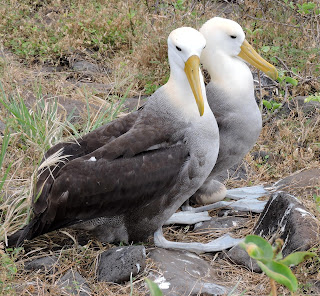 |
| Espaniola frigate bird searching for fish |
 |
| Wave albatross nesting on Espaniola |
Along with Genovesa, Espaniola Island is one of my favorites
so far. Birds, birds and more birds fill
the air with their flight and the ground and bushes with their nests. It is an incredible experience to walk along
a trail and see so many gorgeous birds.
Espaniola is the breeding site for nearly all of the 12,000 pairs of
wave albatrosses in the world. And they
were everywhere.
These birds are not afraid of humans, perhaps because they
aren’t hunted and they nest on an uninhabited island. Both parents sit on the eggs. One parent leaves to bring back fish to his
or her mate sitting on the nest and then they change places. We saw many abandoned eggs, but other nests
had 2 or more eggs. Only one of the
chicks is likely to survive to adulthood.
 |
| Albatross nesting area on Espaniola |
We saw a mother feeding her chick who was frantic for food
even though he was almost as large as his mother. He was still too young to fly, but will need
to learn fast because all the adults will be headed out to sea shortly. Although, there were still some pairs in the
courtship and mating process, so they will have a lot of work ahead of them to
raise their chick.
 |
| Blue footed boobies nesting |
Espaniola is also a key breeding ground for blue-footed
boobies and we saw hundreds of pairs.
These boobies mate for life, but go off in different directions after
they’ve raised their chick, returning to Espaniola in breeding season to fine
each other once again. They are
beautiful birds with their blue feet and bills and black and white bodies. When in search of fish, they circle over the
water and, when they see what they want, dive straight into the water, beak
first and aerodynamic.
Nazca boobies and albatrosses also nest on Espaniola, so
there is lots of competition for the best nesting spots. There are birds nesting on the footpath,
under bushes, in trees, in every bit of open space, on rocks, you name it. What a sight.
I felt so incredibly lucky to be there looking at earnest parents
hatching their eggs and beautiful, fluffy white chicks with black beaks and
eyes filling their nests, nestling against their parents. One older chick sat on a bush with its
parents above it, getting up the courage to attempt flight.
 |
| Galapagos hawk |
We felt lucky to see a
Galapagos hawk, which is large and dark brown, quite the handsome raptor.
 |
| the Nazco Booby also nests on Espaniola |
 |
| blow hole on cliffs where albatross launch themselves into ocean |
Along the cliffs, there is a spot where the albatross leap
into the air and soar off to sea in search of food. The young albatrosses often have to walk
(very awkwardly) long distances to reach the cliff and take off on their first
real flight. Below the cliffs are lava
rocks, one with a blowhole that shoots geysers of water into the air every time
a large wave hits the island.

No comments:
Post a Comment